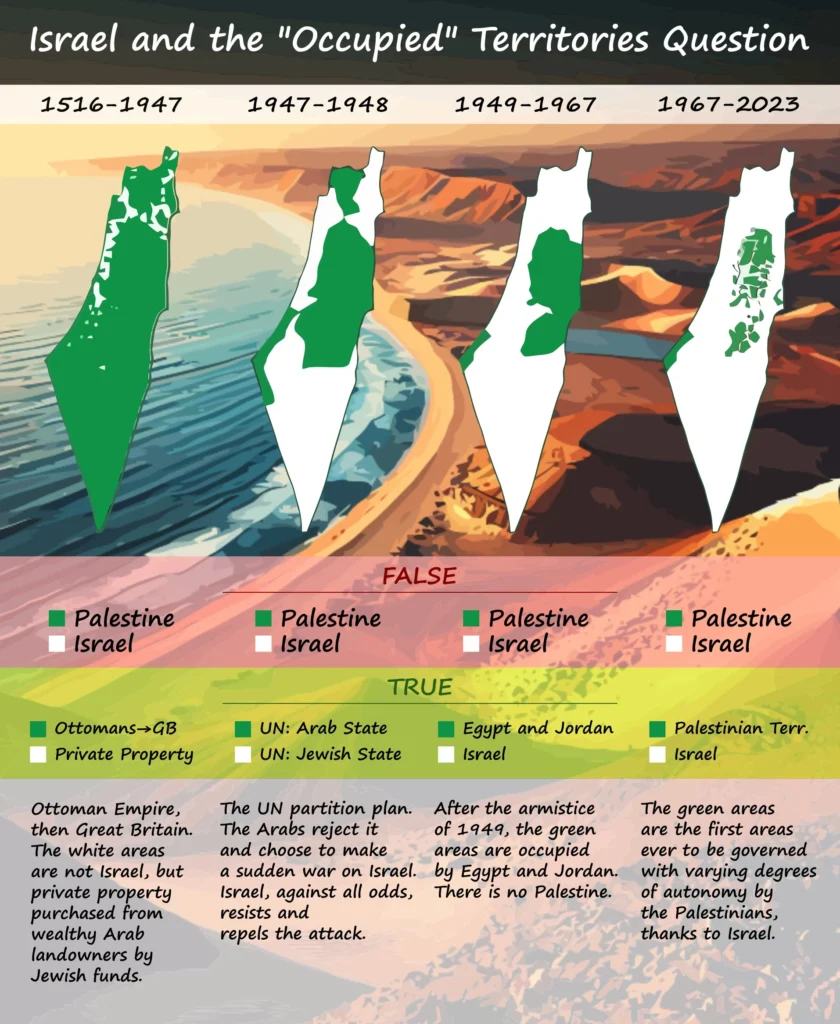
Let’s dismantle in four parts the false narrative on the territories occupied by Israel, a distorted narrative that has been spreading for years through the media around the world. I chose to show this succession of maps because it is one of the most exploited to accuse Israel of being an abusive and occupying nation, when in fact the historical reality is much more complex and articulated.
These graphic representations often omit the historical context, the Israeli defensive wars and the Arab rejection of any diplomatic solution. History shows that Israel did not occupy territories by force to expand, but acquired strategic areas following defensive wars and, in several cases, even gave up lands in exchange for a peace that was unfortunately never cultivated by the other side.
If you are interested in discovering the entire history of Israel, since ancient times, I invite you to read:
👉 Read also: The Whole History of Israel
Contents
- The British mandate (1516-1947)
- Arab attack (1947-1948)
- Arab occupations (1949-1697)
- Palestinian territories (1967-2023)


#1. The British mandate
1516-1947
In the first map, it is alluded to as Jewish settlements beginning to devour Palestine, but this narrative is misleading and does not reflect historical reality. In 1920, the region of Palestine, formerly under the rule of the Ottoman Empire, was assigned to Great Britain as a League of Nations mandate. This mandate was intended to stabilize the area, which at the time was marked by strong ethnic tensions and a general inability of local populations to self-determination. British management was supposed to ensure a political transition until the future definition of the status of the territory.
During this period, the Jewish presence in the region increased through legal land purchases. The white dots visible on the map, often interpreted as colonial settlements, were in fact private properties regularly purchased by Jewish funds. These lands were not fertile or inhabited, but mostly marshy, desert or unproductive, and were voluntarily sold by wealthy Arab landowners at prices well above market value. The buyers were mainly Zionist organizations, whose goal was to reclaim the land and make it arable and habitable, thus contributing to the development of the region.
This aspect is crucial because it dismantles the narrative according to which the Jewish settlements represented a form of territorial aggression or a forced invasion. In reality, these were not territories taken from any Palestinian nation, since such an entity did not exist at that time as a sovereign state. The white areas on the map, therefore, do not symbolize a colonization imposed by force, but private properties acquired legally and improved through a long and complex reclamation work. Furthermore, many of these settlements also brought economic development and job opportunities to the local Arab populations, creating a system that, under normal conditions, could have favored cooperation instead of conflict.
The name Palestine:
This name was imposed by the Romans after the Jewish revolt of 135 AD, when Emperor Hadrian renamed the province of Judea to Syria Palaestina to erase the Jewish identity of the region. The term derives from the Philistines, a non-Semitic people who had disappeared centuries earlier. However, Palestine was never an independent political entity, but only a geographical designation used in successive dominions, including the Romans, Byzantines, Islamic Caliphates, and Ottomans.


#2. Arab attack
1947-1948
In the second map, the UN, with Resolution 181 of 1947, proposes a partition plan that includes the end of the British Mandate and the creation of two states: one Jewish and one Arab. It is important to note that the term “Palestinian” at the time did not indicate a distinct people, but referred to all the inhabitants of the region, including the Jews. Although the territory assigned to Israel was fragmented, of inferior quality, with many marshy and desert areas, the Jewish government nevertheless accepted the plan, seeing it as an opportunity to finally obtain an independent state. The Arab commanders, however, categorically rejected the proposal, considering it unacceptable and unjust, preferring to resort to arms rather than coexistence.
The Arab rejection was not limited to diplomacy: immediately after Israel’s declaration of independence on May 14, 1948, a full-scale war broke out. The neighboring Arab states of Egypt, Jordan, Syria, Lebanon, and Iraq, along with local Arab militias, attacked Israel with the declared aim of annihilating it and its inhabitants. The offensive was coordinated on several fronts, conducted by well-equipped regular armies against a numerically inferior Jewish population with few military resources.
The consequences of the war were devastating: approximately 6,000 Jews, or about 1% of Israel’s population at the time (about 650,000 inhabitants), were killed in the fighting. Among the victims were numerous Holocaust survivors, who, having escaped Nazi concentration camps, found themselves once again fighting for their survival against a new existential threat.
Despite the difficulties, Israel resisted the attack and, against all odds, repelled the Arab aggression. Not only did it survive, but it also managed to consolidate its territory, thus ensuring its existence as a sovereign state, demonstrating that its goal was not expansion, but the defense of its independence against an aggression planned to destroy it.
The Reality of the Nakba:
The Arab term for the Palestinian exodus of 1948, it was actually caused by Arab leaders themselves. When Arab states attacked Israel soon after its independence, they urged local Arabs to temporarily flee, promising that they would return after Israel’s annihilation of the Jews. However, Israel never forced the Arab population to leave, and in many cities Jews explicitly asked Arabs to stay and coexist peacefully. Many Arabs who remained became Israeli citizens, demonstrating that their expulsion was not a systematic action, but the result of individual choices influenced by the war and Arab disinformation.


#3. Arab occupations
1949-1697
In the third map, following the first Arab-Israeli war, the armistice of 1949 was reached, which temporarily redefines the borders of the region. Under the ceasefire agreements, two Arab states took control of territories that were not assigned to them by the UN partition plan: Egypt occupied the Gaza Strip, while Jordan occupied Judea and Samaria, the region now known as the West Bank. It is important to note that these areas were not transformed into a Palestinian state, but remained under the military and administrative control of Egypt and Jordan, without ever creating an autonomous Palestinian government or granting any right of self-determination to the local Arab inhabitants.
During the occupation, neither Egypt nor Jordan recognized any form of Palestinian national sovereignty: the Gaza Strip was administered by the Egyptian government, while Jordan formally annexed the West Bank in 1950, granting citizenship to its inhabitants. However, this annexation was not recognized by the international community, and claims for an independent Palestinian state remained non-existent until the following years.
The concept of the Palestinian people, as we know it today, was still poorly defined in the years immediately following 1949. Only in the following decades would the term Palestine begin to take on a political character, becoming a central element in diplomatic battles and conflicts against Israel. Organizations such as the PLO (Palestine Liberation Organization), founded in 1964, would begin to spread the idea of a Palestinian national identity distinct from other Arab states, while before then no sovereign entity or significant political movement had advanced a request for independence for a hypothetical Palestinian state.
The origins of Jerusalem:
Jerusalem is Jewish and not Islamic for historical, archaeological and religious reasons. Founded over 3,000 years ago by King David, it became the capital of the Kingdom of Israel and home to Solomon’s Temple. Islam, however, was born only in the 7th century AD, over 1,600 years after the Jewish founding of Jerusalem. The Dome of the Rock and the Al-Aqsa Mosque were built later, under Umayyad rule (late 7th century), on a site already sacred to the Jews. Despite its importance to Islam, Jerusalem has never been the capital of any Muslim kingdom or caliphate, while it has always been at the center of Jewish tradition.


#4. Palestinian territories
1967-2023
The fourth map shows the aftermath of the Six-Day War of 1967, a conflict that radically changed the territorial structure of the region. Israel, faced with threats and military movements from Egypt, Syria and Jordan, decided to launch a strategic preemptive operation, striking first and obtaining a crushing victory in just six days. With this war, Israel took control of several territories: the Gaza Strip and the Sinai Peninsula from Egypt, the Golan Heights from Syria, and Judea and Samaria (West Bank) and East Jerusalem from Jordan. Sinai would later be returned to Egypt in 1982, as part of the Camp David Peace Accords, marking the first official recognition of Israel by an Arab country.
Since the 1990s, Israel has begun a process of ceding territories to the Palestinians for their self-management. In 1994, with the Oslo Accords, signed by Yasser Arafat (PLO), Yitzhak Rabin (Israel) and Bill Clinton (USA) as mediator, the ABC areas in Judea and Samaria (West Bank) were defined, some of which passed under the control of the Palestinian National Authority (PNA). Subsequently, in 2005, Israel began the complete cession of the Gaza Strip, evacuating all Israeli settlers and leaving administrative control to the Palestinians. This decision will prove on October 7, 2023 to have been very bad for Israel’s security.
In the 2000s, faced with a wave of Arab terrorist attacks against Israeli civilians, Israel decided to build the separation wall, a defensive barrier to prevent terrorist infiltration and protect the population. Construction began in 2002, during the Second Intifada, and it proved to be an effective element in reducing terrorist attacks inside Israeli territory.
It is important to note that this is the first time in history that the Palestinians have been granted a form of self-government. In fact, neither Egypt nor Jordan, which occupied these territories between 1949 and 1967, had ever granted any autonomy or independence to the Palestinians. Paradoxically, it is only after Israeli control that the possibility of a local Palestinian administration arises, with an autonomy that had never been granted before by previous Arab governments. In essence, the green areas of the last map represent the first historical opportunity for a Palestinian administration, while previously the same territories were under the direct control of Egypt and Jordan, without any concession of self-determination for the local population.
The Failure of the Oslo Accords:
Signed in the years 1993-1995, they were supposed to start a peace process between Israel and the PLO, but were scuppered by Yasser Arafat. Despite having officially accepted the recognition of Israel and Palestinian autonomy in some areas, he continued to support terrorism and incite hatred against Israel. After Oslo, instead of promoting peace, the PLO intensified suicide attacks and violence, culminating in the Second Intifada (2000-2005), which caused thousands of deaths.

Leave a Reply